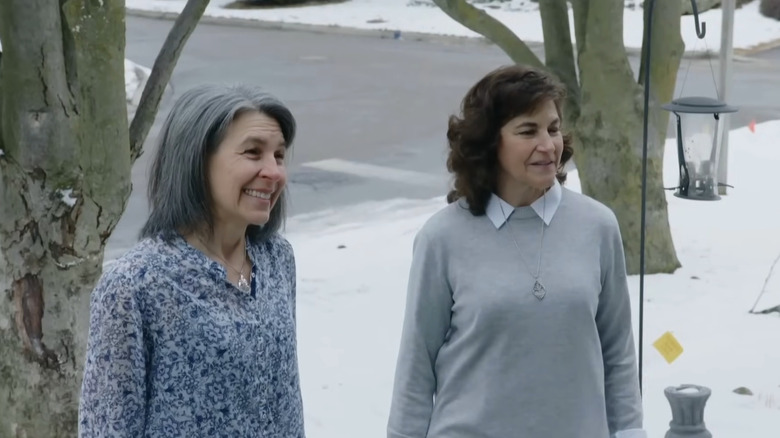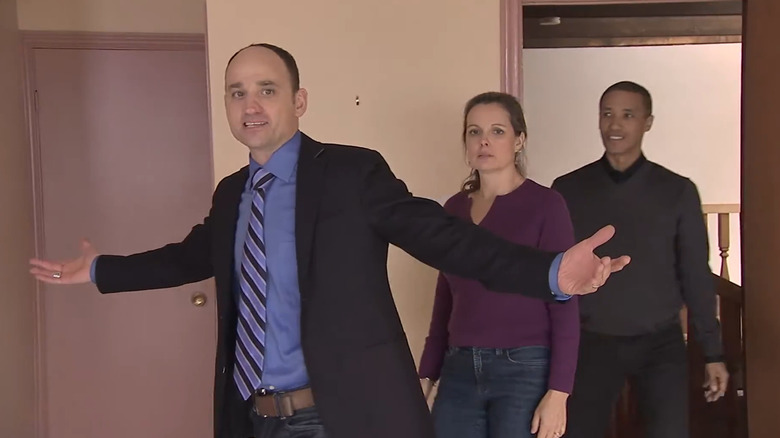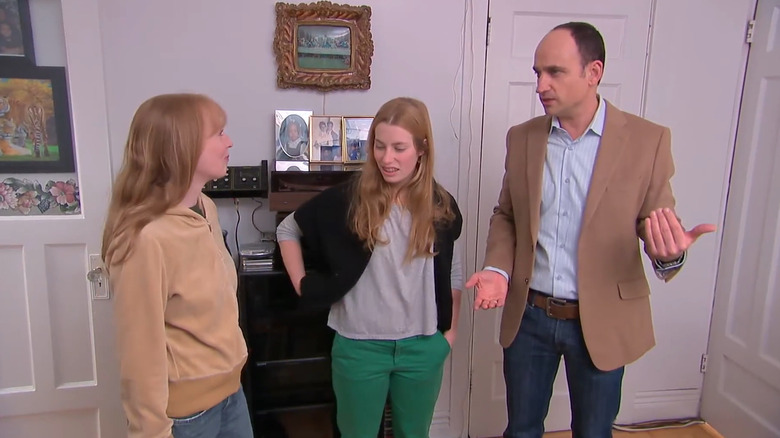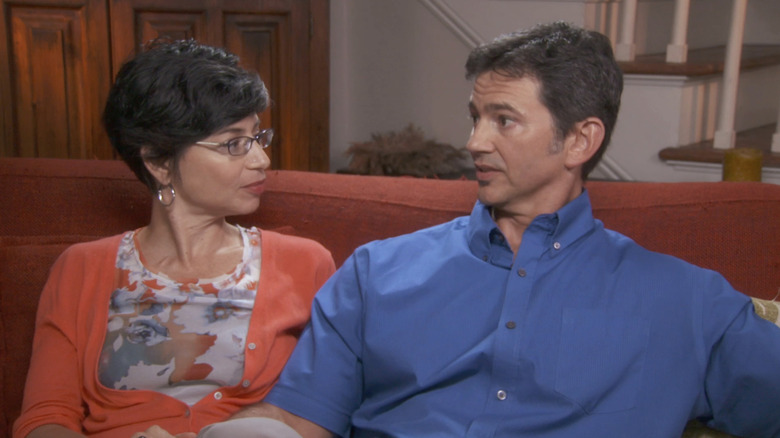Lies From Love It Or List It You Probably Didn't Notice
Reality TV isn't always what it seems, and even your favorite HGTV shows are no different. Just like with any production, there are certain lies from "Love It or List It" you probably didn't notice while watching, even if you've seen every episode. For more than 20 seasons, Hilary Farr and David Visentin, and now Page Turner, have transformed countless homes, and even sold a few, too. Yet, there is a lot more going on behind the scenes than what you may have been led to believe.
Sure, there's the typical reality TV takes, like needing to redo a reaction to a renovation because the sound was muffled, but some of the lies go much deeper. For example, do clients get to keep the "Love It or List It" furniture? Short answer, no, they don't ... at least not without paying. So, if you've ever wondered what's real and what's not, you're not alone — and the truth might just change the way you watch.
It was originally an American show
It's easy enough to assume that since the show is so popular on American television, it must be filmed in the States, too. However, it's actually not! "Love It or List It" is produced by a company called Big Coat Media, which is based in both Canada and the U.S. Even so, here's where HGTV's "Love It or List It" is filmed: the majority of the earlier seasons of the show were filmed in and around Toronto, Canada.
Yet, if you were sure the show did take place in the U.S., you're not entirely wrong, either. As Big Coat Media expanded its operations, later seasons of "Love It or List It" were also filmed in the Raleigh, North Carolina area. "HGTV US, the lead broadcaster for 'Love It or List It,' was interested in sharing the great American lifestyle. So we ventured into the U.S. to expand the scope of the show for our viewers," Executive Producer Maria Armstrong told Raleigh Magazine. Her team chose the area because it's a fast-growing city with a dynamic, ever-changing market. She also shared that the Raleigh area has lots of different types of houses, making it an ideal place for filming because there is so much architectural variety for viewers to enjoy.
Anyone can sign up to be on the show
It might seem like anyone can be on the show if they live near enough to the filming locations, but there is a very strict set of criteria that all potential contestants must meet before they are even considered. For example, it's a given that the house you're trying to either love or list must be in the greater Toronto area. Next, the casting company insists all contestants must admit that they need professional help with their house. In some cases, the required budget to appear on the show is at least $75,000, while other sources claim it's as high as $100,000. While it's not specified that these requirements are listed in Canadian dollars or American dollars, we can assume that, due to filming in Canada, it's the former. Historically, the U.S. dollar has been worth about 25% more than its Canadian counterpart, to help you visualize the true amount of cash needed.
Even if you live in Toronto and have the money saved up for your renovation, the biggest clincher that decides who gets to be a contestant or not is someone who can not only move out of their home for about eight weeks (at their own expense!), but also has the outgoing personality needed to make good TV. It's a tall order, yet the producers don't seem to have trouble filling it.
The producers help with housing during filming
As mentioned, you have to have a pretty penny saved to appear on "Love It or List It," as production doesn't cover the cost of the renovations — that's all on you. However, you also need to save up a pile of cash in excess of that to house yourself, too. The show doesn't cover accommodation for those who appear as homeowners. Instead, it seems like the main benefit of being on the show is access to its stars and their design skills, not anything financial.
In fact, the only time that production might cover anything for its contestants is if there are massive delays in filming that are outside production's control. "We do not cover the cost of the homeowners' temporary living arrangements while their home is being renovated, except in the case of some unexpected circumstances such as delays due to COVID," an HGTV spokesperson told the Greensboro News & Record. So, if everything goes smoothly and filming lasts the two months it's supposed to, homeowners must find a place for their families to live in the meantime without support.
David only works as a real estate agent on Love It or List It
With more than 20 seasons of the show under his belt, you might think that David Visentin doesn't have time to sell houses outside of the show — but this can't be farther from the truth! In fact, he works extensively as a real estate agent even when the cameras aren't rolling. He got his real estate license in 1987 and has been working with Country Living Realty Limited in the Toronto area ever since.
Visentin was inspired by his dad to join the real estate business, as he was also a successful broker. "He's semi-retired, but he has been a real estate agent as long as I can remember," he told Realtor.com. "I came out of high school and was going to go to theater school, and he was, like, 'Well, Dave, you're not going to make any money doing that. Get your real estate license. Then if you want, you can go back to school.'" It's lucky that he landed the spot on "Love It or List It," as it combines his apparent flair for the dramatic with his house-hunting skills, although Visentin is known to provide priceless real estate advice to homebuyers both on and off the screen.
David actually sells the houses that are listed
Since Visentin is a licensed real estate agent, it's easy enough to then assume that when the contestants choose to list their homes, he's the one who goes on to sell them as well. But this isn't actually the case, and that's because of his schedule. The reality is that while he loves being on the show, he only does the original showing, not the selling. "It was a dream extension for me to take my real-estate skills and confidence in front of the camera and put them together for the show," he told AZ Central. Once the choice is made to sell, he hands over the client to work with a local real estate agent to finish the process.
The reason for this is his busy filming schedule. Things move fast, so he has to be available for the show and other commitments instead. "Once someone decides to list it, the agent I work with to find houses takes over and handles all of the logistics," he revealed. "Due to my schedule, it's impossible to juggle all of that information and I'm not involved in that process." This arrangement is very similar to a lie from "My Lottery Dream Home," in that host David Bromstad (who, in his case, isn't an actual licensed real estate agent) works with local brokers to help clients buy homes instead.
The snark on the show is totally real
The series is famous for the back-and-forth between its two hosts. Sometimes, it gets really snippy! However, it's just a bit for TV and no one's feelings are actually getting hurt — nor is anyone getting really annoyed. In fact, both Farr and Visentin are great friends in real life. "Hilary and I got along right off the bat. It's the perfect relationship," Visentin told the Los Angeles Times. "We allow each other to say exactly what the other one feels even if it's irrational. And then we get over it and move on." So, even if the banter seems a little too real, it never crosses the line in their professional relationship.
Visentin went on to tell Realtor.com that this is a dynamic that carries on between him and Farr, even when the cameras aren't rolling. "We're good friends, we hang out outside of the show. We go out for dinners, talk about the show, talk about life," he confirmed to the outlet. "But we're both fairly competitive. So even outside of the show, we've been known to banter and we have to be very careful when we're in public because sometimes we'll just start in on each other." So fans shouldn't be worried, it's all said with love. "What you see on the show is kind of our relationship," he continued.
Hilary doesn't care whether they love it or list it
It's true that more often than not, homeowners on the show end up "loving" their freshly renovated home, instead of "listing" it and moving away. "I don't know the exact number. I mean, we've done around 225 episodes. I would say probably it's 60 to 40 for her," Visentin told Realtor.com in 2021 about how the show typically pans out. "I think that might just be the nature of people having a hard time letting go of their home, even if another one makes more sense."
Because Farr puts so much effort into redoing the client's current property, and tends to win, you might assume she doesn't care whether they love it or list it in the end. Especially because she'll be paid either way! Yet, when the contestants choose to put the home up for sale, it really does bother her. "I really am upset [when a couple lists the house] but would never give David the satisfaction of showing it," she told MEA WorldWide. Her reaction is a reminder that, despite the TV format, there are real emotions, like plenty of pride behind the work she puts into each renovation.
Homeowners have a lot of say in the design process
It might look like contestants work closely with Farr on the renovations during the show, but really, the designers seem to be more in charge of the final look and materials. Marci Lew and her husband Matt appeared on the show in 2015, and although they loved the way their property eventually turned out, the finer details aren't necessarily things they would have picked. "We mentioned a few things that we liked and didn't like, but in the end, they've got great designers who make the final choices," Marci told Delish.
For example, she explained that Farr and her team of contractors chose white quartz countertops for her kitchen. While she can admit that the counters are lovely, she "probably would have chosen a darker, more practical color," as white countertops can be tricky to keep clean. Plus, another drawback is that white quartz countertops can yellow over time. Not only that, but some of the functional aspects of the redesign didn't quite work for her family's lifestyle, either. "The drawer freezers they installed didn't have the space we needed," she said. So while the end result of a "Love It or List It" episode may be magazine-worthy, homeowners have to compromise on personal preferences in exchange for professional polish, then make a few post-show tweaks to better suit their day-to-day needs. When working with a typical contractor, this is what to learn from "Love It or List It's" unhappy clients: Always speak up!
Everyone loves being on the show and is happy with their experience
Sometimes, the homeowners featured on the show are so unhappy with the renovations carried out that they feel compelled to file a lawsuit. In 2016, contestants Deena Murphy and Tim Sullivan sued Big Coat TV and Aaron Fitz Construction LLC. They alleged that they paid $140,000 up front to appear on the show, then a further $10,000 after the initial renovations were finished as "change fees" for alterations. "We took out a substantial loan for this and you know, we put in some of our own money," Sullivan told CBS News about the experience. Their lawyer, Jim White, told the outlet the lawsuit alleged that it wasn't right to have to pay for the changes, as the contractors did poor work in the first place.
Yet, after the lawsuit was filed, the accused filed a lawsuit of their own, alleging not only libel and slander, but also negative product claims that could impact their business. After parts of their counterclaim were rejected, the defendants appealed the decision to the North Carolina Court of Appeals in November 2016. A joint motion to dismiss was submitted by both parties on April 21, 2017 and the court officially dismissed the case three days later, on April 24. The details of the settlement remain confidential and have not been made public. So while the show's reputation suggests universal satisfaction, this case serves as a reminder that not every homeowner walks away happy!








